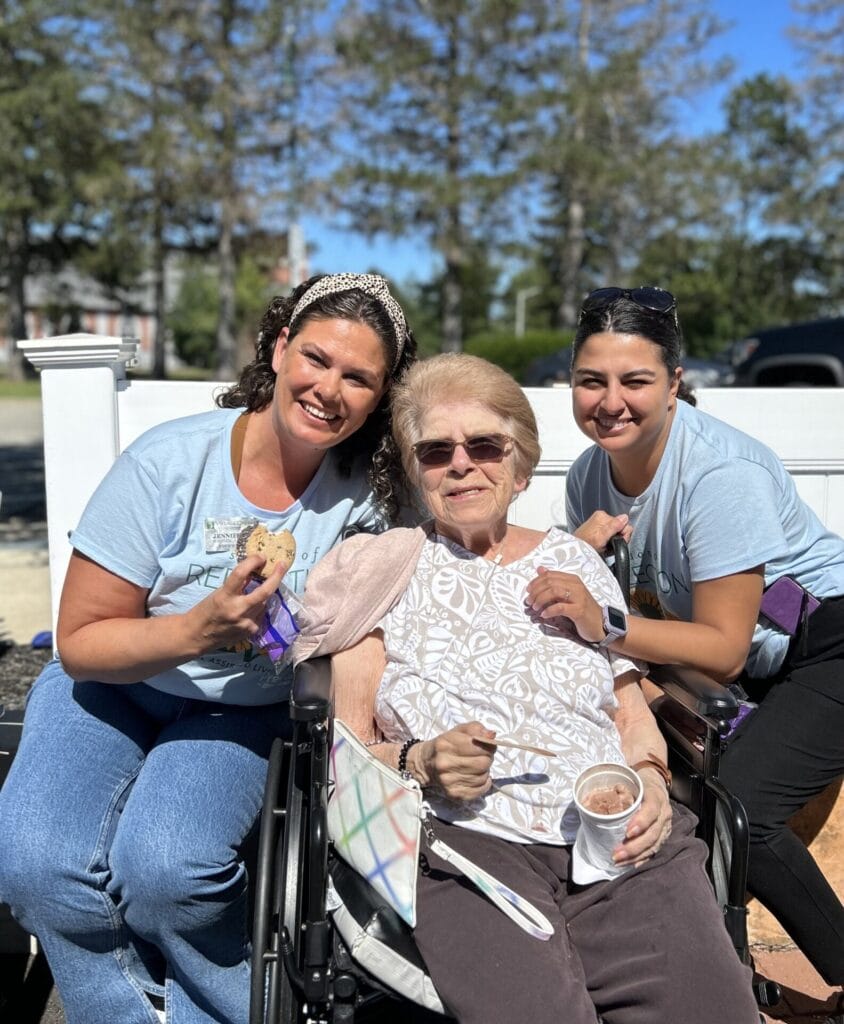Caring for yourself or a loved one with dementia can be enriching and challenging. Between juggling family, work, and time for yourself, the cost of in-home dementia care can affect all aspects of a person’s life.
Yet, with careful planning, support, and expert resources, there’s no reason to worry. With the right village, there’s nothing caregivers can’t accomplish.
For more than 30 years, the senior living experts at Village Green have helped caregivers and families across New York State deliver more compassionate and comprehensive caregiving to their loved ones.
If this is your first time stumbling upon us, welcome! In this guide, we’ll discuss everything you need to know to provide cost-conscious, compassionate, and comprehensive in-home care to people with dementia.
Key factors that affect the cost of dementia care

The cost of dementia tends to vary according to the following three factors:
- Home location
- The type — and amount — of dementia care provided
- The caregiver’s training and experience (if any)
Let’s take a look in greater detail at these factors.
Home location
Depending on where you live, the cost of dementia care will differ.
For example, if you lived in an urban city in New York versus a rural town in North Dakota, the cost of dementia care would look different.
Calculating the exact cost of at-home dementia care can be tough. But, families in the U.S. spent between $68,000 and $76,000 for at-home health care services with home health aides, according to a 2023 Statista.com dataset.
Depending on the state — and how much your in-home caregiver charges — the cost will differ.
Type and amount of dementia care provided
The cost of in-home dementia care can differ depending on the amount of care a person needs. For example, a full-time caregiver who works a 40-hour week at $36 an hour will cost about $5,760 a month (Ziprecruiter.com, 2024).
Whether a resident requires extra home health services besides dementia care can also affect the total cost of in-home care.
The caregiver’s training and experience
Worth noting is the fact that caregivers don’t hold the same credentials. Caregivers come with different levels of experience, certifications, and training.
For instance, whether you hire a registered nurse (RN) or a home health aide, a caregiver’s credentials will affect the average monthly cost of home care and memory care for you and your loved one.
Services included with in-home dementia care
Individuals who pay for in-home dementia care and other long-term care services can expect dementia caregivers and care providers to provide the following senior care services to those who live with dementia:
- Companionship and opportunities for socializing
- A care plan including personal care for activities of daily living (ADLs) such as medication management, housekeeping, bathing, and eating
- Help with managing symptoms for early and late-stage dementia
- Long-term care services and supervision so you focus on taking care of yourself and your family
- Activities that nurtures your loved one’s interests, skills, and well-being
And more, caregivers can provide a tailored care plan for each dementia stage. The goal of in-home dementia care services is to ensure that seniors stay safe and engaged.
Costs of home and safety modifications for dementia care
Of course, staying safe may mean adapting parts of your home. Many families and caregivers find that paying for dementia care for a senior with dementia means structural changes to a senior’s home.
The average cost of in-home safety modifications can add up over time. Many caregivers spend upwards of thousands of dollars to ensure their loved one’s dementia is manageable both for their loved ones and themselves.
The costs of home modifications depend on how much your loved one’s dementia has progressed. We’ve organized this progression into two different categories:
- Early-stage dementia costs
- Late-stage dementia costs
Early-stage dementia costs
Typical home modifications made for individuals who have early-stage dementia include the following:
- Removing common trip hazards
- Installing grab bars in high-traffic areas
- Removing steps and adding ramps and leveled walkways for easier accessibility
As dementia progresses, other indoor and outdoor modifications may be needed.
Later-stage dementia costs
In later stages of dementia, seniors may need more dedicated care and attention. For example, walking can be challenging for seniors with late-stage dementia. Seniors may also be at greater risk for wandering and falling.
As seniors head into later-stage dementia, costs of care rise. For example, the following home modifications can cost a pretty penny:
- Alarmed windows and doors
- Keypad entry and exits
- Non-slip flooring
- Walk-in tubs and showers
- Lever handles
- Stairlifts (for those with mobility challenges)
- New appliances with automatic shut-off functions
Many caregivers opt for providing the same above-mentioned holistic care solutions with the help of a dedicated memory care community. Memory care facilities include the latest assistive and adaptive technologies to ensure the health of those with late and early-stage dementia.
While memory care costs may differ from in-home care costs, caregivers and loved ones can ensure their loved one receives the right care needed with both options.
Other hidden costs of in-home dementia care
Providing care for a loved one can be one of the most rewarding commitments of a person’s life. But doing so also comes with a few hidden costs.
Lesser known areas to consider when budgeting for the cost of care for an older adult include:
- The emotional and mental cost associated with dementia care
- Job-related costs
- Financial costs related to covering care expenses
The emotional and mental health costs of providing dementia care
Providing elder care is tough, no doubt. Studies show that a majority of dementia caregivers live with some level of depression, anxiety, and stress.
Balancing an elderly loved one’s care with personal responsibilities is tough. Add a career, child care, and personal relationships into the mix, and you can see why caregivers often rely on respite care for support.
If you’re thinking about long-term care for your loved one, consider the fact that caregivers often spend three to four — or more — hours a week on elder care.
The emotional, mental, and financial-related costs of caregiving are real when providing care for a loved one.
Job-related financial costs of providing in-home care
People who are considering providing care to a loved one should consider the job-related and financial costs of doing so. For example, many caregivers often have to miss work to take their loved ones to doctor’s appointments and emergency calls.
If left unchecked, these added responsibilities can affect job performance. Caregivers can expect lost pay and fewer vacation days as well.
All things considered, in-home care costs may be lower than paying for skilled nursing care or relying on an adult day care center or nursing home.
Opting to provide care for a loved one requires scrupulous detail. If you’re up for the job, check out the documents and resources needed to prepare for in-home dementia care.
What to consider when paying for dementia care
Many people providing care in the United States to a loved one with dementia do so through private funds, savings, pensions, long-term care insurance plans, and other income sources.
Common care costs to consider when paying for dementia care include:
- The cost of medications
- Regular doctor visits
- Treatment for health conditions (like depression and hearing/vision loss)
To help pay for in-home dementia care, you’ll want to have all your ducks in a row. Having the right documents and resources in order will help you pay for care with little trouble and ensure you’re ready for the journey ahead.
Documents needed for dementia care
Common financial documents needed to cover dementia and memory care costs include:
- Bank and brokerage account information
- Insurance policies
- Medical power of attorney
- Monthly bills
- Retirement benefits summaries
- Rental income paperwork
- Written wills
- Stock and bond certificates
- Social Security payments and information
After collecting these documents, you’ll want to check which documents you’re missing. Legal or financial advisors can help with this task.
Also, advisors can help with sorting out legal documents needed — such as assigning power of attorney and guardianship. The good news is that plenty of resources exist to help caregivers with the document collection process and with covering the cost of in-home dementia care.
Resources available to cover in-home dementia care costs
The following private and government-sponsored financial resources are available to caregivers when planning for dementia care costs:
- Private and government insurance programs: Medicare, disability insurance, group employee plans, life insurance, long-term care insurance, Social Security Disability Income (SSDI), Supplemental Security Income (SSI), Medicaid, Veterans’ benefits, tax deductions, and more
- Community support services: to cover some of the cost of respite workers, transportation, meal delivery, and support services
- Retirement benefits
- Personal savings, assets, and investments
At any point, you can always contact your local assisted living facility, memory care community, adult day health care center, or nursing home care provider to better understand the scope and cost of in-home dementia care.
The staff at these facilities would be happy to break down the cost of memory care for you and/or your loved one.
Summary: A breakdown of in-home dementia care costs
| Type of cost | Description |
| Services | 1. Providing companionship and opportunities for socializing 2. Help with activities of daily living (ADLs) such as medication management, housekeeping, bathing, and eating 3. Help with managing symptoms for early and late-stage dementia 4. Planning activities that nurture your loved one’s interests, skills, and well-being |
| Home and safety modifications | Early-stage dementia: 1. Removing common trip hazards Installing grab bars in high-traffic areas 2. Removing steps and adding ramps and leveled walkways for easier accessibility Late-stage dementia: 1. Alarmed windows and doors 2. Keypad entry and exits 3. Non-slip flooring 4. Walk-in tubs and showers 5. Lever handles 6. Stairlifts (for those with mobility challenges) 7. New appliances with automatic shut-off functionality |
| Emotional and mental costs | 1. Potential added anxiety, stress, and depression 2. Respite care for you when you need time off 3. Added responsibility of balancing personal relationships and job-related goals |
| Job-related and financial costs | 1. Potential for missing days at work 2. Potential for decreased job performance 3. Potential for loss of vacation days |
Find the answers you’re seeking for dementia care
Providing in-home dementia care can result in four major costs:
- Costs related to care services provided
- Home and safety modifications needed to provide excellent care
- Emotional and mental costs on the caregiver and their family
- Job-related and financial costs
Aside from paying for extra hours of care per week to cover memory care, caregivers can take advantage of a variety of dementia care options to provide more compassionate, comfortable, and holistic care.
If you’re looking for an all-in-one, inclusive experience where seniors receive the care they need, assisted living and memory care may be right for you.
To learn more about the care your loved one can receive at an assisted living or memory care community, don’t hesitate to contact one of our friendly and knowledgeable senior living patient navigators.
They’d be happy to help you through the ins and outs of how assisted dementia care can help you and your loved one thrive.
Frequently asked questions about in-home dementia care
Can Medicare cover the costs of in-home dementia care?
Alas, Medicare doesn’t cover the cost of in-home dementia care. But, Medicare care can cover some dementia-related care costs.
Cognitive assessments, medications, and care planning are a few services that Medicare covers.
Can private health insurance cover the cost of dementia care?
Private health insurance plans tend to cover parts of medical care for a senior who has dementia. For example, some employer-sponsored health and Medigap insurance plans will cover expenses like inpatient hospital treatment, prescription medications, and select doctor appointments.
How about memory care? How much does it cost?
The cost of memory care depends on which state and memory care floor plan you choose. In general, memory care tends to be a bit more expensive than assisted living. Yet, memory care is more affordable than a nursing home.
Feel free to reach out to one of our senior living planners to find out what the cost of living is like in your community.
“My mom was treated like royalty.”
Every single person at Village Green has touched my life in ways there are no words for. Mom was treated like a sort of royalty that everyone knew.
Every second of every day I knew when I couldn’t be there with her, everyone there was loving and caring for her. Not just because it was their job, but because they genuinely loved her.
I never worried, I never felt uneasy, and most importantly, Mom was always happy.
I saw that time and time again with so many staff members at Village Green, and that’s priceless to me.” – Paulina, one of our esteemed family members at Village Green.




